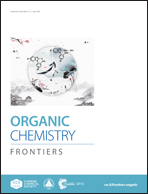Transition metal catalysed C7 and ortho-selective halogenation of 2-arylbenzo[d]oxazoles†
Abstract
2-Arylbenzo[d]oxazole is an important structural motif in pharmaceutical chemistry, while its regioselective halogenation still remains challenging due to the many possible reaction sites on the two aromatic systems. Herein, we report a transition metal catalysed chlorination, bromination and iodination of 2-arylbenzo[d]oxazole with N-halosuccinimide, in which ruthenium-catalysed halogenation occurred on the C7-position and rhodium-catalysed halogenation occurred on the ortho-position. The C7 halogenation was only observed for 5-methyl-2-(p-substituted)arylbenzo[d]oxazoles under rhodium catalysis. Preliminary mechanistic experiments and density functional theory (DFT) calculations suggested that the C7-halogenation catalysed by Ru might have a single-electron-transfer (SET) radical process, while the ortho-selective halogenation catalysed by Rh proceeds probably through a redox-neutral SN2-type mechanism. The different selectivity of Rh catalysed halogenation could be due to the charge difference between benzo[d]oxazolyl and aryl rings. The two kinds of halogenated products were proved to be versatile by constructing aryl and alkynyl groups on the C–X site via Suzuki and Sonogashira cross-coupling reactions.
![Graphical abstract: Transition metal catalysed C7 and ortho-selective halogenation of 2-arylbenzo[d]oxazoles](/en/Image/Get?imageInfo.ImageType=GA&imageInfo.ImageIdentifier.ManuscriptID=C9QO00429G&imageInfo.ImageIdentifier.Year=2019)


 Please wait while we load your content...
Please wait while we load your content...